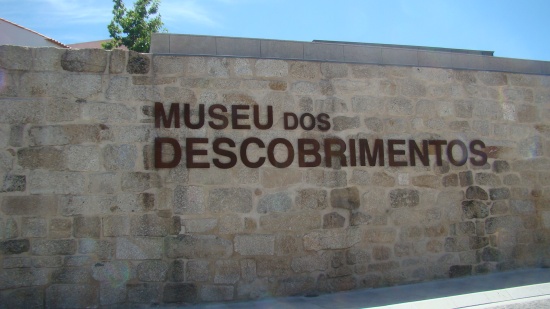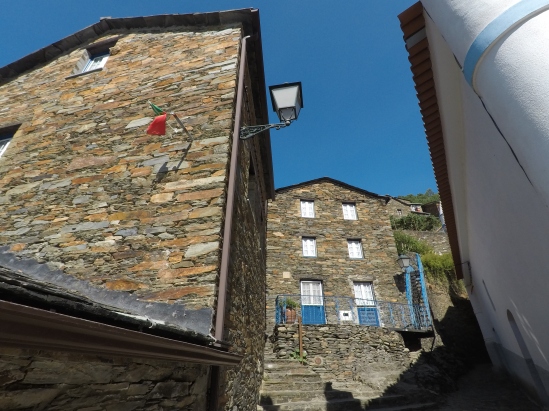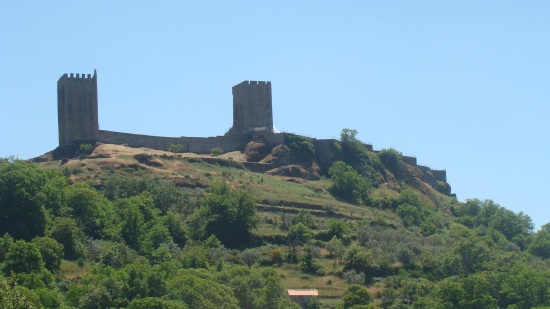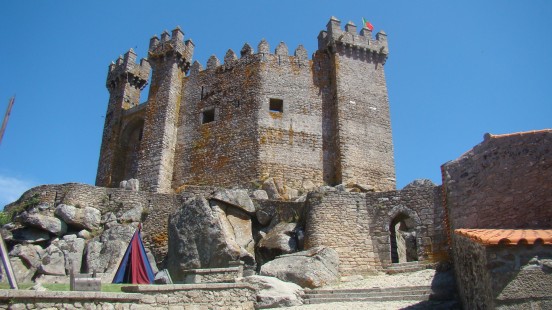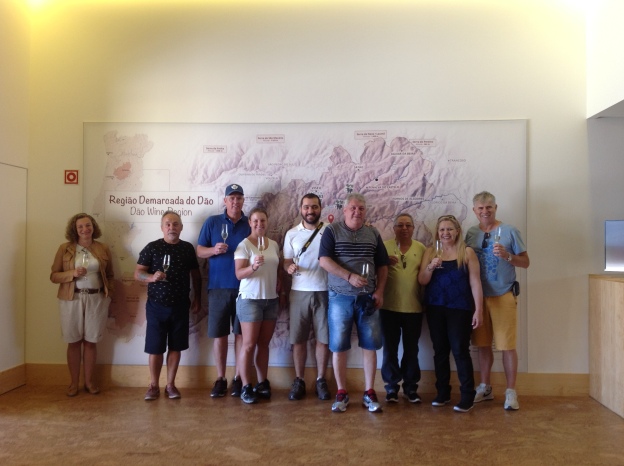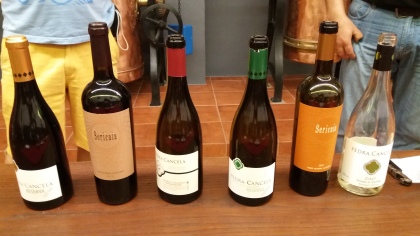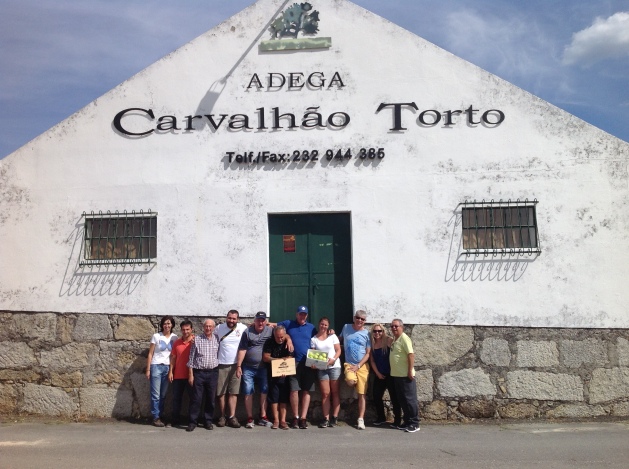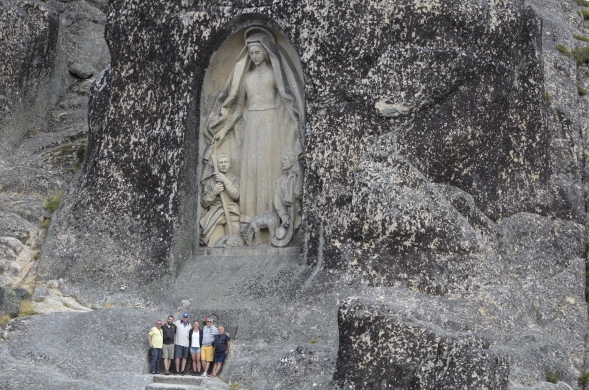Desde os tempos de Viriato, lendário herói português, a região da Serra da Estrela encerra segredos e mistérios em sua história. Mas não para nós. Neste roteiro, vamos conhecer tudo sobre a produção do queijo, dos artigos de lã, do azeite e da história desta belíssima região com 8 das 12 Aldeias Históricas de Portugal.
Uma viagem perfeita para as férias com crianças!
Partiremos da cidade do Porto em direção à Beira Interior, e nossa primeira parada é Trancoso e seu castelo fundado nos sécs. VIII-IX em terra de fronteira, palco de diversas lutas e batalhas marcantes para a formação e independência do reino português. Foi aqui que D. Dinis celebrou suas bodas com a Rainha Santa, D. Isabel de Aragão, em 1282.

Ali pertinho conheceremos o Castelo de Penedono e a Lenda das Duas Pedras Brancas: durante o século XI, o castelo pertençeu a uma bela moura, muito rica. Conta a lenda que as duas pedras brancas ao lado direito da fachada, são as tampas de duas caixinhas misteriosas, aí deixadas pela bela moura, para esconder a sua fortuna. A fim de que ninguém lhe roubasse, ela colocou numa caixa todos os seus tesouros e na outra a peste que causaria a morte imediata de quem se atrevesse a abrir. Como ninguém sabe em qual das caixas se escondia o tesouro, ninguém até hoje, se atreveu a tentar abrí-las, porque, quem remover a pedra errada libertará a peste que matará todos os habitantes da região. Melhor seguir viagem, né?
Já perto da fronteira com a Espanha, visitaremos Castelo Mendo, uma aldeia de características medievais, constituída por 2 núcleos amuralhados, a Cidadela e a Barbacã que foram de suma importância na defesa fronteiriça contra o reino de Leão e Castela.
A estrutura de defesa nesta região se une a Almeida cuja origem credita-se a celtiberos, dominados em 61 a.C. pelos romanos e depois pelos árabes que a chamaram de Al-Mêda (a Mesa, por sua localização), Talmeyda ou Almeydan e que aí construíram um pequeno castelo (séc. VIII- IX) cujas proporções aumentaram “um pouco” com o tempo.
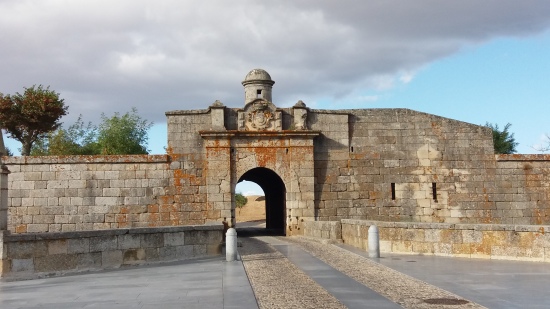
Historicamente, nenhuma povoação de fronteira exerceu por tanto tempo, um lugar tão relevante nas relações Luso-Castelhanas e na defesa do território português quanto Figueira de Castelo Rodrigo um autêntico espaço monumental que conserva importantes referências no plano medieval. Estando numa das várias rotas de peregrinos a Santiago de Compostela, aqui se ergueu a Igreja de N. Sra. de Rocamador, fundada por uma confraria de frades hospitaleiros vindos de França no séc. XIII. Em compensação, por ter tomado partido de Castela na crise de 1383-85, D. João I castigou Castelo Rodrigo, mandando que o seu brasão ficasse com as armas reais invertidas. Porém vamos ver que este muda de Portugal a Espanha e vice-versa não era nada incomum para os castelos de fronteira.
Diz a tradição que o nome Belmonte provém do lugar onde a vila se ergue (monte belo ou belo monte). Porém, há quem lhe atribua a origem de “belli monte” – monte de guerra. A história de Belmonte surge associada à história aos judeus, pois é a terra portuguesa onde a presença dos judeus é mais forte, destacando-se por ter sido um caso singular, no território peninsular, de permanência da cultura e da tradição hebraicas desde o início do século XVI até aos dias de hoje. Há um museu homenageando a comunidade que, durante séculos, resistiu aos éditos de expulsão dos reis católicos, ao decreto de expulsão ou conversão de D. Manuel I, ao olhar vigilante da Santa Inquisição e às penas do seu tribunal. Peças da Idade Média ao séc. XX, utilizadas por judeus e cristãos-novos no quotidiano ou nas práticas religiosas, encontram-se neste espaço museológico. A história de Belmonte também é associada à história dos Cabrais. Eles mesmo, pois é a terra natal de Pedro Álvares Cabral, o navegador, que no ano de 1500 comandou a segunda armada à India, durante a qual se descobriu oficialmente o Brasil. Então tem o Museu do Descobrimento, a estátua do Cabral, a casa do Cabral, a escola do Cabral, enfim…

Próxima aldeia: Sortelha, uma das mais belas e antigas vilas portuguesas que de tão bem preservada, possibilita ao visitante recuar aos séculos passados, no castelo do séc. XIII, por entre as sepulturas medievais, junto ao pelourinho manuelino ou defronte igreja renascentista. Muita história mesmo.
Piódão é uma das aldeias mais pitorescas de Portugal, ao mesmo tempo escondidade e majestosa ao revelar-se. Suas casas distribuem-se em redor de socalcos, nas quais pontuam o azul e o xisto, por entre sinuosas ruelas. Uma graça mesmo.
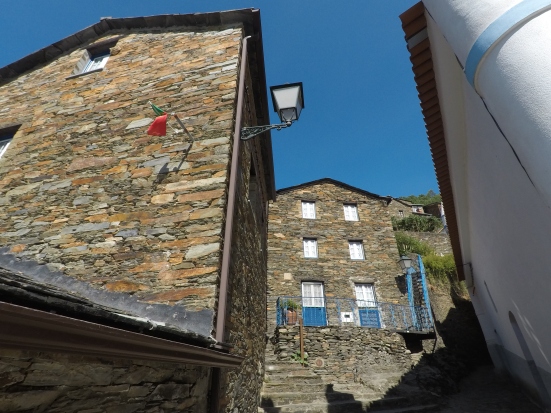
Falando de Serra da Estrela, não podemos esquecer do seu ponto mais alto, as Penhas Douradas, da lã típica da região e do famoso queijo.
Para fechar o circuito de aldeias, veremos a aldeia medieval do séc. XII, Linhares da Beira que possui uma diversidade arquitetônica ímpar, fruto do legado de várias épocas. Região que antigamente era muito próspera em comércio, contava também com uma importante comunidade judaica, minoria étnica e religiosa obrigada a viver apartada da comunidade cristã e cujo bairro – denominado judiaria.

Fecharemos nossa viagem em Viseu que foi várias vezes residência dos condes D. Teresa e D. Henrique, pais de D. Afonso Henriques que teria nascido ali a 5 de agosto de 1109. Só para lembrar, D. Afonso Henriques é considerado ninguém menos que o pai de Portugal por ter unificado todas as regiões do agora país e mandado para casa os mouros que estavam por lá já há alguns séculos.
Voltando a Viseu, esta data da época dos celtiberos, prova disso é que encontraram num altar pagão datado do séc. I, as seguintes inscrições: “Às deusas e deuses vissaieigenses. Albino, filho de Quéreas, cumpriu o voto de bom grado e merecidamente.” Com a Romanização, a cidade ganhou grande importância, devido ao entroncamento de estradas romanas, por isso Viseu está associada à figura de Viriato, já que se pensa que este herói lusitano tenha talvez nascido nesta região.
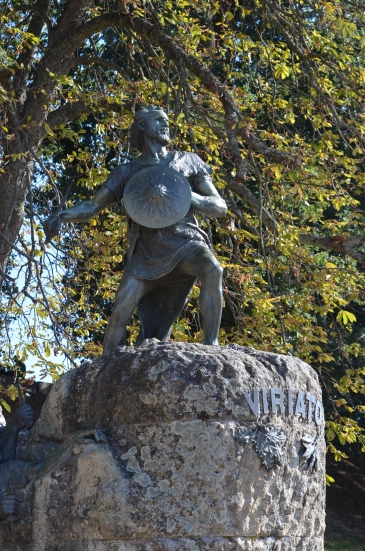
E outra lenda bacana que inclusive está representada no brasão da cidade. O rei Ramiro II de Leão, em viagem para outras terras, conheceu Sara, a irmã de Alboazar, rei do castelo de Gaia, e se apaixonou a tal ponto que raptou Sara. Ao saber do sucedido, o irmão de Sara vingou-se raptando a esposa do rei, D. Urraca. Ferido no orgulho, D. Ramiro teria escolhido em Viseu alguns dos seus melhores guerreiros para o acompanharem, penetrando sorrateiramente no castelo, e deixando os guerreiros nas proximidades. Enquanto Alboazar caçava, D. Ramiro conseguiu entrar no castelo e encontrar D. Urraca que, sabendo da traição do marido, recusou-se a acompanhá-lo. Quando Alboazar regressou da caça, D. Urraca decide vingar-se do marido mostrando-o ao raptor. Ramiro, aprisionado e condenado à execução, pede para, como último desejo, morrer ao som da sua buzina, que era o sinal que tinha combinado com os soldados para entrarem no castelo. Ao final do sexto toque, os soldados cercam imediatamente o castelo, incendiando-o. Alboazar morreria nas mãos dos soldados do rei Ramiro. Parabéns a D. Urraca e pena que D. Ramiro se saiu com a sua, mas assim é a história.
Viseu tem muita história, é uma cidade muito bonita (premiada várias vezes como a melhor cidade da Europa para se viver) e tem lojas, shoppings etc, para você poder levar além das lembranças, muita coisa bonita para casa.
Vem com a gente, vem!
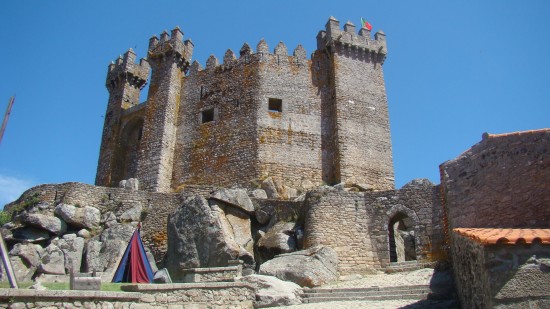
Since the days of Viriato, the legendary Portuguese hero, the region of Serra da Estrela holds secrets and mysteries. But not for us. In this tour, we will know the production of cheese, woollen articles, olive oil and the history of the splendid region with 8 of the 12 Historical Villages of Portugal.
A perfect trip for the holidays with children!
We will leave the city of Porto towards Beira Interior, and our first stop is Trancoso and its castle founded in the 18th century. Stage of many fights and striking battles for the formation and independence of the Portuguese kingdom. It was here that D. Dinis celebrated his wedding with the Holy Queen, D. Isabel de Aragão, in 1282.

Nearby we find Castle of Penedono and the Legend of the Two White Stones: during the eleventh century, the castle belonged to a graceful, rich Moor-woman. Legend tells that the two white stones on the right side of the facade are the covers of two mysterious little boxes, left there by the Moor, to hide her fortune. So that no one robbed her, she placed her treasures in one of the boxes and in the other the plague that causes the immediate death of those who dared to open it. Since no one knows in which of the boxes, the treasure was hidden, no one dared to open them, because whoever removes the wrong stone will free the plague that will kill all the inhabitants of the region. Better to move on with our trip, huh?
Closer to Spain, we will visit Castelo Mendo. A village of medieval characteristics made up of 2 walled nuclei, the Cidadela and Barbacã, which were of great importance in the frontier defence against the kingdom of Leon and Castile.
The defense system of this region likewise counts with Almeida which origin is credited to Celtiberians, dominated in 61 BC by the Romans and then by the Arabs who called it Al-Mêda (the table, for its location), Talmeyda or Almeydan and that there was built a small castle (8th-9th century) whose proportions increased “a bit” over time.
No frontier settlement has existed for so long and so relevant in Luso-Castelhanas relations and in the defence of Portuguese territory as Figueira de Castelo Rodrigo. An authentic monumental space that preserves important references in the medieval plan.
Located on one of the several routes of pilgrims to Santiago de Compostela, the Church of Our Lady of Rocamadour was founded here by a confraternity of hospitable friars coming from France in the 19th century. By taking the protection of Castile in the crisis of 1383-85, D. João I punished Castelo Rodrigo, ordering his coat of arms to have the royal arms upside down. But, we see that this change from Portugal to Spain and vice versa was common for a border castle.
Tradition says the name Belmonte comes from the place where the village rises (beautiful hill or mount) but, some attribute it to the origin of “belli monte” – the mound of war.
Belmonte’s history is associated with the Jews because where the presence of the Jews stands out. It was a singular case in the peninsular territory of the permanence of the Hebrew culture and tradition from the 16th century to the present day.
There is a museum honouring the community that for centuries resisted the edict of expulsion from Catholic kings, the decree of expulsion or conversion of King Manuel I, the watchful eye of the Holy Inquisition and the penalties of its court. Objects from the Middle Ages to the XX century, used by Jews and New Christians in daily life or religious practices are found in this museum.
Belmonte is further linked to the Cabrais. Yes, they themselves. Because it is the birthplace of Pedro Álvares Cabral, the navigator, who in the year 1500 commanded the second armada to India when Brazil was officially discovered. Then there is the Discovery Museum, the statue of Cabral, the house of Cabral, the school of Cabral, you get the picture …
Next village: Sortelha, one of the most fascinating and old villages so well preserved that it takes the visitor back for centuries, in the castle of the XIII century, close to the medieval graves, next to the Manueline pillory or in front of the Renaissance church. A lot of history.
Piódão is a charming village, at once hidden and majestic when it unveils itself. Their houses are distributed around terraces, in which they punctuate the blue and the schist, among sinuous alleys. A real delight.
Speaking of Serra da Estrela, we can not forget its highest point, Penhas Douradas, the typical wool of the region and the famous cheese.
To close the circuit of villages, we will see a medieval village of the XII century. Linhares da Beira has a unique architectonic diversity, the legacy of several centuries. A very prosperous region in commerce in their days, it too had an important Jewish community, an ethnic and religious minority forced to live separated from the Christians in their neighbourhood – denominated judiaria.
We will finish our trip in Viseu that was used as a residence by counts D. Teresa and D. Henrique, parents of D. Afonso Henriques who was born there August 5th, 1109. Just as a reminder, D. Afonso Henriques is none other than the father of Portugal for having unified all regions of the now country and sending home the Moors who were there for several centuries.
Back to Viseu, that dates from the time of the Celtiberians, proof of this is they found on a pagan altar dated from the first century the following inscriptions: “To the Goddesses and the Gods Vissaieigenses. Albino, son of Quensas, fulfilled the vote willingly and deservedly”. With the Romanization, the city gained great importance, due to the intersection of Roman roads, so Viseu is linked with the figure of Viriato since it is thought that the Lusitanian hero may have been born in this region.
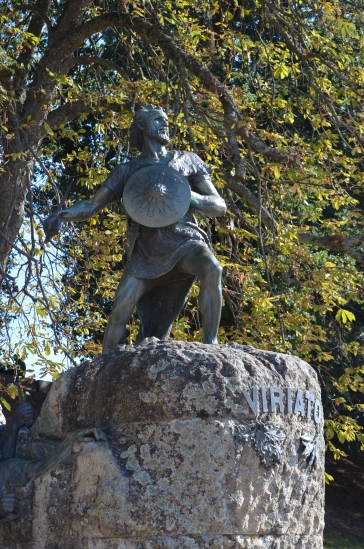
Another nice legend is represented in the coat of arms of the city: King Ramiro II of Leon, on a journey abroad, met Sara, the sister of Alboazar, king of the castle of Gaia, and fell so much in love he kidnapped Sara. On learning what had happened, Sara’s brother took avenge by kidnapping the king’s wife, D. Urraca. Wounded in pride, D. Ramiro chose in Viseu his best warriors, sneaked alone into the castle, and left his warriors nearby. While Alboazar was hunting, D. Ramiro found D. Urraca, who, knowing of her husband’s betrayal, refused to go with him. When Alboazar returned from hunting, D. Urraca took revenge on her husband by showing him the abductor. Ramiro, imprisoned and sentenced to execution, asks as his last wish to die at the sound of his horn, which was the signal for his soldiers to invade the castle. At the end of the sixth ring, the soldiers at once surround the castle, setting it on fire. Alboazar died at the hands of King Ramiro’s soldiers. Cuddles to D. Urraca and sorry that D. Ramiro was able to escape, but such is history.
Viseu historic heritage is vast, a delightful city (awarded several times as the best city to live in Europe) and it has shops, malls etc, so you can take not only memories but still something beautiful home.
Come with us!













